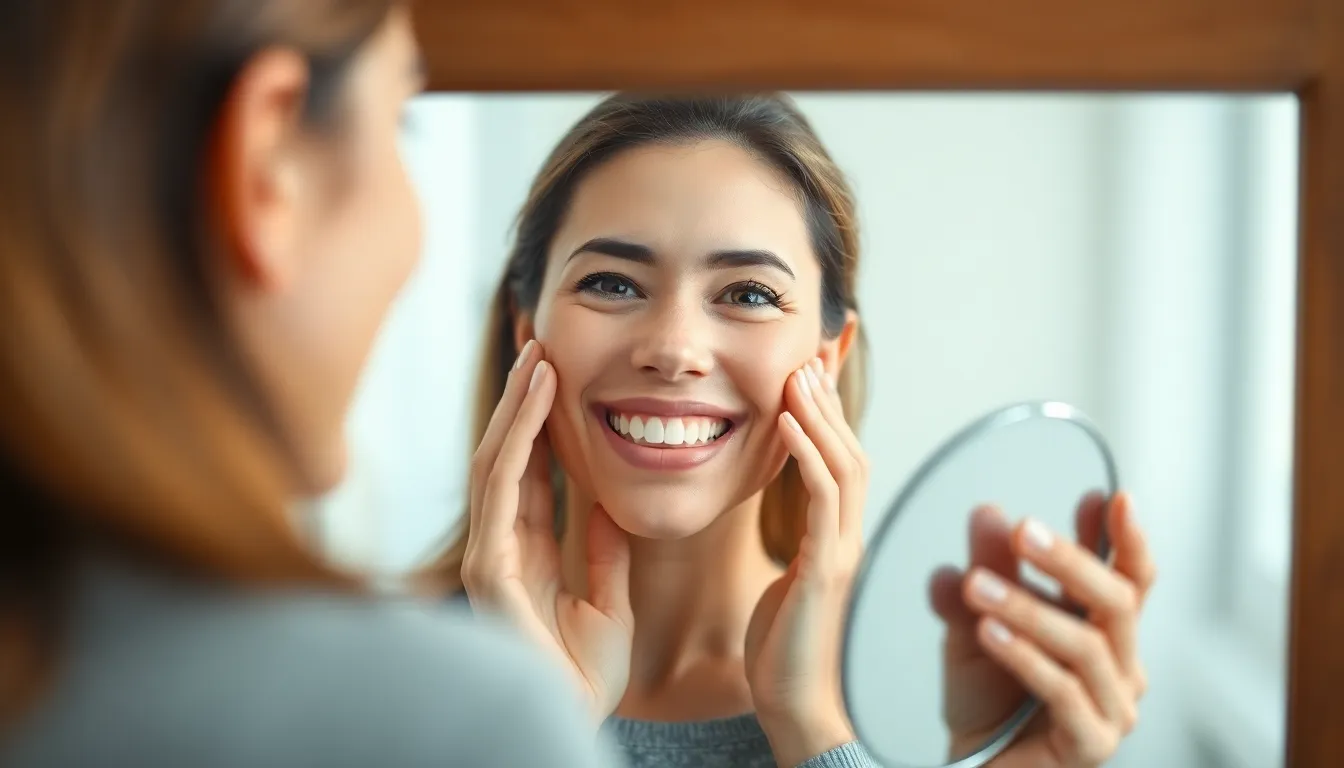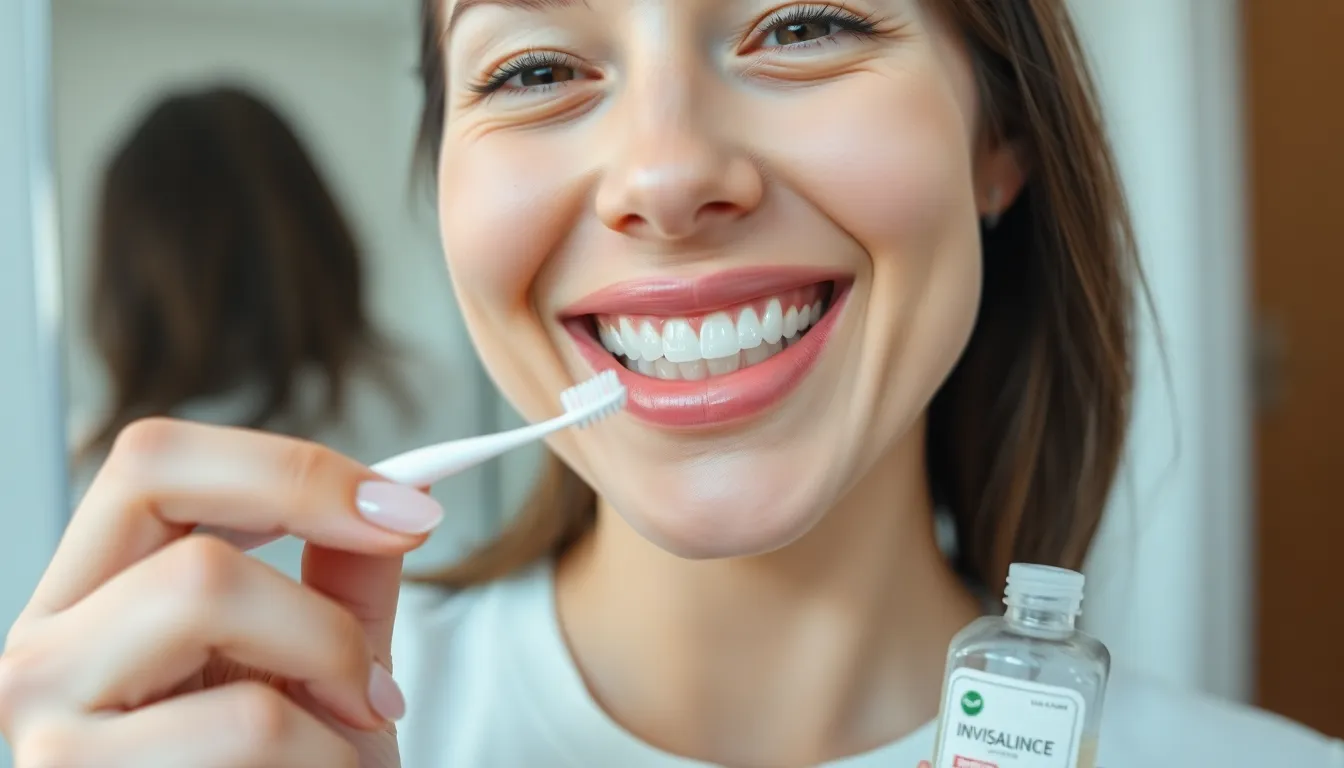Are your teeth barely visible when you smile? You’re not alone in this common concern that affects both confidence and social interactions. Many people feel self-conscious about their “gummy smile” or hidden teeth when expressing joy.
Understanding why your teeth don’t show when you smile is the first step toward finding a solution. This could be due to several factors including naturally short teeth, a high lip line, or overdeveloped gum tissue. The good news? Whether you’re preparing for an important photo opportunity or simply want to feel more confident in everyday situations, various cosmetic and dental options can help create the smile you’ve always wanted.
Understanding Why Your Teeth Don’t Show When You Smile
A smile with minimal tooth display can stem from various anatomical factors. Many patients like Sarah, who visited our practice last year, express concern about their “disappearing teeth” when smiling. Dr. Todd B. Harris often explains that this common issue has several distinct causes.
Anatomical Reasons for Hidden Teeth
Your upper lip position plays a crucial role in tooth visibility during smiling. Lips that cover a important portion of your teeth create what dentists call a “low smile line.” Genetics largely determines your lip position and muscle attachments, explaining why certain smile characteristics run in families. Teeth length also impacts visibility—shorter teeth due to wear, genetics, or developmental factors naturally show less when you smile. Jaw alignment affects tooth display too, with certain bite relationships (especially overbites) causing upper teeth to tuck behind the lower lip.
The Impact of Aging on Your Smile
Age-related changes gradually alter your smile’s appearance over time. Enamel erosion and general tooth wear reduce tooth height by 1-2mm per decade after age 40, decreasing visible tooth structure. Facial muscles naturally lose elasticity with age, causing your upper lip to relax and cover more of your upper teeth. Dr. Harris notes that many patients don’t realize their smiles have changed until viewing old photographs. Bone resorption in your jaw further compounds these effects by altering facial proportions and reducing support for facial tissues.
Habits That May Hide Your Teeth
Certain unconscious behaviors contribute to hidden teeth during smiling. Tension in your facial muscles from stress or anxiety often creates tight, restrained smiles that show less tooth structure. Habitual lip positioning, developed over years as a self-conscious response to dental concerns, becomes automatic and difficult to change. Many patients adopt protective smiling patterns after experiencing dental insecurity, particularly during adolescence. These ingrained habits persist even after addressing the original dental concerns through treatment.
Common Causes of Hidden Teeth During Smiling

Hidden teeth when smiling stem from several factors that fall into two primary categories: anatomical structure and muscular habits. Understanding these causes can help you identify why your teeth don’t show prominently during smiles.
Anatomical Factors
Your natural lip shape and size significantly impact tooth visibility during smiling. A longer upper lip often covers teeth completely, regardless of how wide you smile. This anatomical variation is perfectly normal but can create a “low smile line” where minimal tooth structure appears.
Gummy smiles occur when excessive gum tissue displays more prominently than your teeth. This condition results from genetics, an overactive upper lip muscle that lifts too much when smiling, or a naturally high gum line positioning.
Small or worn teeth contribute substantially to limited tooth display. Teeth that have experienced erosion, grinding damage, or are naturally petite simply don’t extend far enough to show prominently. Loss of tooth volume frequently happens due to age-related wear, traumatic damage, or decreasing jaw bone density.
Misaligned teeth or jaw issues create barriers to a full tooth display. Problems like overbites, underbites, and crowded teeth can cause certain teeth to hide behind others or position in ways that make them less visible during smiling. Uneven gum lines further complicate this situation by creating inconsistent tooth exposure.
Dr. Harris notes, “Many patients come to me concerned about their ‘disappearing teeth’ when smiling, not realizing that simple anatomical factors are often the cause. One patient with a naturally long upper lip was amazed at how a minor lip repositioning procedure completely transformed her smile confidence.”
Muscle Tension and Habits
Facial muscle tension around your mouth can restrict how widely you smile. Chronic stress often manifests in tight facial muscles that limit the natural movement of your lips, preventing them from revealing your teeth fully when smiling.
Overactive muscles in your upper lip area contribute to reduced tooth visibility. This muscle hyperactivity pulls the lip in ways that either cover your teeth or expose more gum tissue than teeth, creating an imbalanced smile appearance.
Protective smiling habits develop unconsciously if you’ve experienced dental insecurities. Many people train themselves to smile with closed lips or minimal tooth exposure if they’ve felt self-conscious about their teeth in the past, creating a persistent habit that’s difficult to break.
How to Evaluate Your Smile

Understanding why your teeth don’t show when you smile starts with proper evaluation. By examining exact aspects of your smile, you can identify potential causes and determine appropriate answers.
Self-Assessment Techniques
Checking your gum-to-teeth ratio provides important insights about your smile. If gums cover a large portion of your teeth when smiling, you likely have a “gummy smile” where excess gum tissue or an overactive upper lip conceals your teeth. Many patients in Dr. Harris’s practice discover this is their primary issue after a simple mirror assessment.
Take time to observe your teeth size and condition carefully. Naturally small teeth or worn-down teeth significantly reduce visibility when smiling, creating the impression of hidden teeth. Your upper lip length plays a crucial role in tooth display – longer upper lips typically cover more of your teeth, resulting in less visibility during smiles.
Try standing in front of a mirror and smiling naturally to evaluate which teeth show. Notice if your upper teeth remain completely hidden or if only lower teeth appear, as this might indicate bite alignment problems such as overbite or underbite affecting your smile’s appearance.
When to Consult a Dental Professional
Consulting a dentist becomes necessary if you notice signs of gum disease, tooth decay, or other oral health issues preventing proper tooth display. These conditions require professional diagnosis and treatment to improve both function and appearance.
For gummy smiles, scheduling an appointment with a dentist or periodontist allows for assessment of excess gum tissue and muscle activity. These specialists offer effective treatments like gum contouring or lip repositioning to enhance tooth visibility and smile aesthetics.
Worn-down teeth or facial collapse due to aging responds best to treatment from specialists in anti-aging or cosmetic dentistry. These professionals provide answers that restore tooth length and facial structure without causing tooth damage, addressing age-related changes affecting your smile.
Bite problems directly impact smile visibility and require orthodontic intervention. Orthodontists treat overbites, underbites, and other alignment issues using braces, clear aligners, or alternative methods customized to your exact needs.
Cosmetic answers represent another pathway to improved tooth display. Options include orthodontics for alignment, veneers or crowns for size and shape enhancement, and even lip fillers to lift the upper lip – all customizable approaches based on your unique smile characteristics.
Solutions for Revealing More Teeth When Smiling

Improving tooth visibility when smiling involves addressing the underlying causes through professional treatments or at-home techniques. These answers range from simple exercises to more comprehensive dental procedures, depending on your exact situation.
Dental Treatments and Procedures
Dental professionals offer several effective treatments to improve tooth display during smiling. Gum contouring (gingivectomy) reshapes excess gum tissue that may be covering your tooth surface, creating a more balanced smile with increased tooth visibility. Orthodontic treatments like braces or clear aligners can reposition misaligned teeth and jaws, optimizing tooth display and overall smile aesthetics. For patients with small or worn teeth, restorations such as veneers, crowns, or bridges add length and volume, making teeth more prominent when smiling.
“Many patients come to me concerned about their ‘disappearing teeth’ when smiling,” notes Dr. Todd B. Harris. “After examining their dental structure, we often find that simple procedures like gum reshaping can dramatically transform their smile appearance without extensive treatment.”
In more severe cases involving jaw irregularities, orthognathic surgery provides comprehensive correction, though it’s typically reserved for important functional or aesthetic concerns. Night guards protect against further tooth wear for patients who grind their teeth, preventing additional shortening that contributes to hidden teeth.
Exercises to Train Your Smile Muscles
Facial exercises strengthen and enhance control of the muscles responsible for lip movement during smiling. Regular practice of lip exercises increases flexibility and mobility, potentially allowing your upper lip to rise higher when smiling. Try practicing smiling in front of a mirror while consciously focusing on lifting your upper lip slightly more than feels natural – this trains the lip elevator muscles over time.
Another effective exercise involves placing your index fingers at the corners of your mouth and gently pulling outward while smiling, creating resistance that strengthens the smiling muscles. Performing these exercises for 5-10 minutes daily yields noticeable improvements in lip positioning for many patients within a few weeks.
Additional options include lip lift surgery, which permanently shortens the upper lip to reveal more teeth, and temporary lip fillers that can subtly reshape lip contours for enhanced tooth display. These options prove particularly beneficial for patients with naturally longer upper lips that cover important portions of their teeth when smiling.
Psychological Impact of Concealed Teeth

Hiding your teeth when smiling affects far more than just your appearance—it often reflects deeper psychological concerns. This common behavior, known as a “closed-mouth smile,” typically stems from dental insecurities that can significantly impact your overall mental wellbeing and social interactions.
Psychological Effects
Concealing your teeth when smiling frequently indicates a lack of confidence or low self-esteem, particularly about your dental appearance. Many individuals develop this habit as a protective mechanism, using a closed-mouth smile to shield themselves from potential judgment or criticism about their teeth. This emotional restraint doesn’t just affect your smile—it can manifest as broader social anxiety, causing you to withdraw from social situations or limit personal connections out of fear that others might notice your dental imperfections.
Dr. Harris notes, “In my practice, I’ve observed countless patients who’ve spent years hiding their smiles. One patient shared that she’d avoided being in photos at her daughter’s wedding because she was embarrassed about her teeth. The psychological burden these patients carry is often more important than the dental issue itself.”
Boosting Confidence in Your Smile
Improving your smile confidence starts with addressing the underlying concerns about your teeth. Cosmetic dentistry offers many options to improve dental appearance, from whitening treatments to more comprehensive answers like veneers or orthodontics. These physical improvements often trigger remarkable psychological transformations as patients feel free to express themselves fully through genuine smiles.
Practicing self-acceptance represents another powerful approach to overcoming smile anxiety. Understanding that perfect teeth aren’t a prerequisite for a beautiful smile helps reduce the pressure you might feel in social situations. Many people with “imperfect” smiles are perceived as more approachable and authentic.
Building a supportive social network also plays a crucial role in developing smile confidence. Surrounding yourself with people who appreciate you beyond physical appearances creates safe spaces where you can smile freely without fear of judgment. Positive social interactions gradually reinforce that your smile—regardless of how much teeth it shows—is an important expression of your personality rather than a flaw to conceal.
Celebrity Smiles: Before and After Transformations

Celebrity smile transformations showcase dramatic dental improvements that changed how their teeth appear when smiling. Many stars who once had minimal tooth display or alignment issues now flash perfect, brilliant smiles thanks to modern cosmetic dentistry procedures. These transformations highlight the potential answers available for anyone concerned about teeth not showing when smiling.
Miley Cyrus’s Smile Evolution
Miley Cyrus underwent a complete smile makeover from her Hannah Montana days. Her early career photos reveal crooked teeth that she often concealed with closed-lip smiles. After orthodontic treatment followed by porcelain veneers, Miley’s transformation resulted in a radiant smile with prominent tooth display. Her confidence visibly increased as her dental aesthetics improved, demonstrating how dental work can change both appearance and self-assurance.
Tom Cruise and His Iconic Grin
Tom Cruise’s smile transformation stands as one of Hollywood’s most notable dental makeovers. Early in his career, Cruise had misaligned teeth with a noticeable midline discrepancy that limited his smile’s impact. Through a combination of orthodontics and veneers, he achieved the perfectly aligned, white smile that’s now part of his signature look. His transformation illustrates how correcting alignment issues can dramatically enhance tooth visibility when smiling.
The Kardashian-Jenner Smile Effect
Kim Kardashian’s smile evolution demonstrates the power of cosmetic dentistry in creating picture-perfect grins. Her before photos showed less tooth display and minor alignment issues, while her current smile features ideally shaped, brilliantly white teeth that show prominently when she smiles. Experts believe veneers played a important role in her transformation, creating the balanced, symmetrical smile she’s known for today.
Dr. Harris notes, “I’ve had patients bring in photos of Kim Kardashian’s smile as inspiration. What many don’t realize is that achieving that level of transformation often requires addressing multiple factors that affect tooth display, not just color or alignment.”
Lindsay Lohan’s Dental Journey
Lindsay Lohan’s smile underwent a important transformation throughout her career. Her earlier photos revealed color variations and alignment issues that often resulted in closed-lip smiles or limited tooth display. After getting veneers, her teeth became whiter, more symmetrical, and more visible when smiling. This change enhanced her overall facial expressions and on-camera presence, demonstrating how dental work can transform not just a smile but one’s entire appearance.
Celebrity Smile Transformation Data
| Celebrity | Initial Issue | Solution | Result |
|---|---|---|---|
| Miley Cyrus | Crooked teeth, closed-lip smiles | Orthodontics, porcelain veneers | Radiant smile with full tooth display |
| Tom Cruise | Misaligned teeth, midline discrepancy | Orthodontics, veneers | Perfectly aligned, prominent smile |
| Kim Kardashian | Minor alignment issues, less tooth display | Veneers, possible whitening | Symmetrical, white, highly visible teeth |
| Lindsay Lohan | Color differences, alignment problems | Porcelain veneers | Whiter, more symmetrical smile |
| Pete Davidson | Gaps, alignment issues | Veneers | Balanced, natural-looking smile |
| Jennifer Lopez | Proportional concerns | Veneers, possible whitening | Iconic, bright smile with perfect tooth display |
Conclusion
Your smile is uniquely yours and there are answers to help you feel confident showing your teeth. Whether you’re dealing with a gummy smile short teeth or muscular habits that hide your smile you have options.
From simple cosmetic procedures to comprehensive dental work modern dentistry offers pathways to enhance tooth visibility. Remember that many celebrities once concealed their smiles too before transformations changed their confidence.
Consult with a dental professional to determine which approach best suits your exact situation. With the right treatment and perhaps some practice you can achieve a smile that feels authentically you. The journey to smile confidence starts with understanding your concerns and taking that first step toward addressing them.
Frequently Asked Questions
What causes a gummy smile or hidden teeth when smiling?
A gummy smile or hidden teeth can result from several factors. These include having a high lip line, short teeth due to genetics or wear, excessive gum tissue, misaligned teeth or jaw issues, and uneven gum lines. Muscular habits like tension in facial muscles or protective smiling patterns developed from past dental insecurities can also contribute. Additionally, aging affects smile appearance through enamel erosion and loss of facial muscle elasticity.
How can I evaluate if I have a “low smile line”?
To evaluate your smile, check your gum-to-teeth ratio when smiling naturally in a mirror. In a balanced smile, about 1-2mm of gum should show above your upper teeth. Notice if your upper lip covers a significant portion of your teeth or if your teeth appear shorter than average. For a comprehensive assessment, consult a dental professional who can evaluate your smile dynamics and recommend appropriate solutions.
What treatments are available for improving tooth visibility when smiling?
Several treatments can enhance tooth visibility: gum contouring removes excess gum tissue; orthodontics corrects alignment issues; veneers or crowns can lengthen short teeth; lip repositioning can address a high lip line; and Botox can relax overactive lip muscles for gummy smiles. For those with worn teeth, cosmetic dentistry can restore length and facial structure. Treatment plans are typically customized based on individual smile characteristics.
Can psychological factors affect how I show my teeth when smiling?
Yes, psychological factors significantly impact smiling patterns. Many people develop a “closed-mouth smile” due to dental insecurities, leading to low self-esteem and social anxiety. These protective habits often form unconsciously after negative comments or self-consciousness about dental appearance. Addressing both the physical dental concerns and the underlying psychological factors is important for developing genuine smile confidence.
How long do cosmetic dental procedures take to improve smile appearance?
Treatment timelines vary based on the procedure. Simple treatments like teeth whitening provide immediate results. Veneers typically require 2-3 appointments over 2-4 weeks. Orthodontic treatments for alignment issues can take 6-24 months depending on complexity. Gum contouring results are visible after healing (about 1-2 weeks). Your dentist can provide a personalized timeline based on your specific treatment plan and smile goals.
Are there any non-surgical options for improving a gummy smile?
Yes, several non-surgical options exist for gummy smiles. Botox injections can temporarily relax the upper lip muscles to reduce gum exposure when smiling, lasting about 3-4 months. Dental veneers can rebalance tooth proportions, making teeth appear longer relative to gum tissue. Orthodontic treatments may help in cases where tooth positioning contributes to excessive gum display. These options are typically less invasive and have shorter recovery times than surgical approaches.
How do celebrities achieve such dramatic smile transformations?
Celebrity smile transformations typically involve comprehensive cosmetic dentistry. Most undergo a combination of treatments including porcelain veneers, teeth whitening, orthodontics (often invisible aligners), gum contouring, and sometimes dental implants. These procedures address multiple concerns simultaneously, from tooth color and shape to alignment and proportion. While costly (often $30,000+), these transformations dramatically enhance tooth visibility and overall smile aesthetics.
Will dental insurance cover treatments for improving my smile?
Dental insurance typically covers treatments deemed medically necessary but rarely covers purely cosmetic procedures. Functional issues like misaligned bites or dental damage may receive partial coverage. Purely aesthetic treatments like veneers, cosmetic bonding, and elective gum contouring are usually not covered. Many dental offices offer payment plans or financing options to make cosmetic treatments more affordable. Always check with your insurance provider about specific coverage details.







